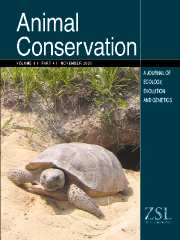Crossref Citations
This article has been cited by the following publications. This list is generated based on data provided by
Crossref.
Ansorge, Hermann
2001.
Assessing non-metric skeleton characters as a morphological tool.
Zoology,
Vol. 104,
Issue. 3-4,
p.
268.
Seymour, Ayesha M.
Montgomery, Margaret E.
Costello, Brian H.
Ihle, Sonja
Johnsson, Greg
St. John, Barbara
Taggart, David
and
Houlden, Bronwyn A.
2001.
High effective inbreeding coefficients correlate with morphological abnormalities in populations of South Australian koalas (Phascolarctos cinereus).
Animal Conservation,
Vol. 4,
Issue. 3,
p.
211.
VØLLESTAD, L
2001.
Developmental stability in brown trout: are there any effects of heterozygosity or environmental stress?.
Biological Journal of the Linnean Society,
Vol. 74,
Issue. 3,
p.
351.
Fréchette, Marcel
and
Daigle, Gaétan
2002.
Growth, survival and fluctuating asymmetry of Iceland scallops in a test of density-dependent growth in a natural bed.
Journal of Experimental Marine Biology and Ecology,
Vol. 270,
Issue. 1,
p.
73.
Réaale, Denis
and
Roff, Derek A.
2003.
INBREEDING, DEVELOPMENTAL STABILITY, AND CANALIZATION IN THE SAND CRICKET GRYLLUS FIRMUS.
Evolution,
Vol. 57,
Issue. 3,
p.
597.
Karvonen, Eevi
Merilä, Juha
Rintamäki, Pekka T.
and
Van Dongen, Stefan
2003.
Geography of fluctuating asymmetry in the greenfinch,Carduelis chloris.
Oikos,
Vol. 100,
Issue. 3,
p.
507.
Réale, Denis
and
Roff, Derek A.
2003.
INBREEDING, DEVELOPMENTAL STABILITY, AND CANALIZATION IN THE SAND CRICKET GRYLLUS FIRMUS.
Evolution,
Vol. 57,
Issue. 3,
p.
597.
Bradshaw, Don
2003.
Vertebrate Ecophysiology.
Dworkin, Ian
2005.
A STUDY OF CANALIZATION AND DEVELOPMENTAL STABILITY IN THE STERNOPLEURAL BRISTLE SYSTEM OF DROSOPHILA MELANOGASTER.
Evolution,
Vol. 59,
Issue. 7,
p.
1500.
Dworkin, Ian
2005.
A STUDY OF CANALIZATION AND DEVELOPMENTAL STABILITY IN THE STERNOPLEURAL BRISTLE SYSTEM OF DROSOPHILA MELANOGASTER.
Evolution,
Vol. 59,
Issue. 7,
p.
1500.
Shikano, Takahito
Ando, Daisei
and
Taniguchi, Nobuhiko
2005.
Relationships of vertebral deformity with genetic variation and heterosis in the guppy Poecilia reticulata.
Aquaculture,
Vol. 246,
Issue. 1-4,
p.
133.
Pertoldi, C
Kristensen, T N
Andersen, D H
and
Loeschcke, V
2006.
Developmental instability as an estimator of genetic stress.
Heredity,
Vol. 96,
Issue. 2,
p.
122.
Kurbalija, Zorana
Kenig, B.
Plavsa, Jovana
Stamenkovic-Radak, Marina
and
Andjelkovic, M.
2010.
The effect of lead on the developmental stability of Drosophila subobscura through selection in laboratory conditions.
Archives of Biological Sciences,
Vol. 62,
Issue. 1,
p.
83.
Băncilǎ, Raluca
Van Gelder, Iris
Rotteveel, Erik
Loman, Juke
and
Arntzen, J. W.
2010.
Fluctuating asymmetry is a function of population isolation in island lizards.
Journal of Zoology,
Vol. 282,
Issue. 4,
p.
266.
Özener, Bariş
2010.
Effect of inbreeding depression on growth and fluctuating asymmetry in Turkish young males.
American Journal of Human Biology,
Vol. 22,
Issue. 4,
p.
557.
Novicic, Zorana Kurbalija
Stamenkovic-Radak, Marina
Pertoldi, Cino
Jelic, Mihailo
Veselinovic, Marija Savic
and
Andjelkovic, Marko
2011.
Heterozygosity Maintains Developmental Stability of Sternopleural Bristles inDrosophila subobscuraInterpopulation Hybrids.
Journal of Insect Science,
Vol. 11,
Issue. 113,
p.
1.
Baker, Karis H.
and
Hoelzel, A. Rus
2013.
Fluctuating asymmetry in populations of British roe deer (Capreolus capreolus) following historical bottlenecks and founder events.
Mammalian Biology,
Vol. 78,
Issue. 5,
p.
387.
Lazić, Marko M.
Kaliontzopoulou, Antigoni
Carretero, Miguel A.
Crnobrnja-Isailović, Jelka
and
Reina, Richard
2013.
Lizards from Urban Areas Are More Asymmetric: Using Fluctuating Asymmetry to Evaluate Environmental Disturbance.
PLoS ONE,
Vol. 8,
Issue. 12,
p.
e84190.
Lacy, Robert C.
and
Alaks, Glen
2013.
Effects of Inbreeding on Skeletal Size and Fluctuating Asymmetry of Peromyscus polionotus Mice.
Zoo Biology,
Vol. 32,
Issue. 2,
p.
125.
Özener, Bariş
and
Graham, John H.
2014.
Growth and fluctuating asymmetry of human newborns: Influence of inbreeding and parental education.
American Journal of Physical Anthropology,
Vol. 153,
Issue. 1,
p.
45.


